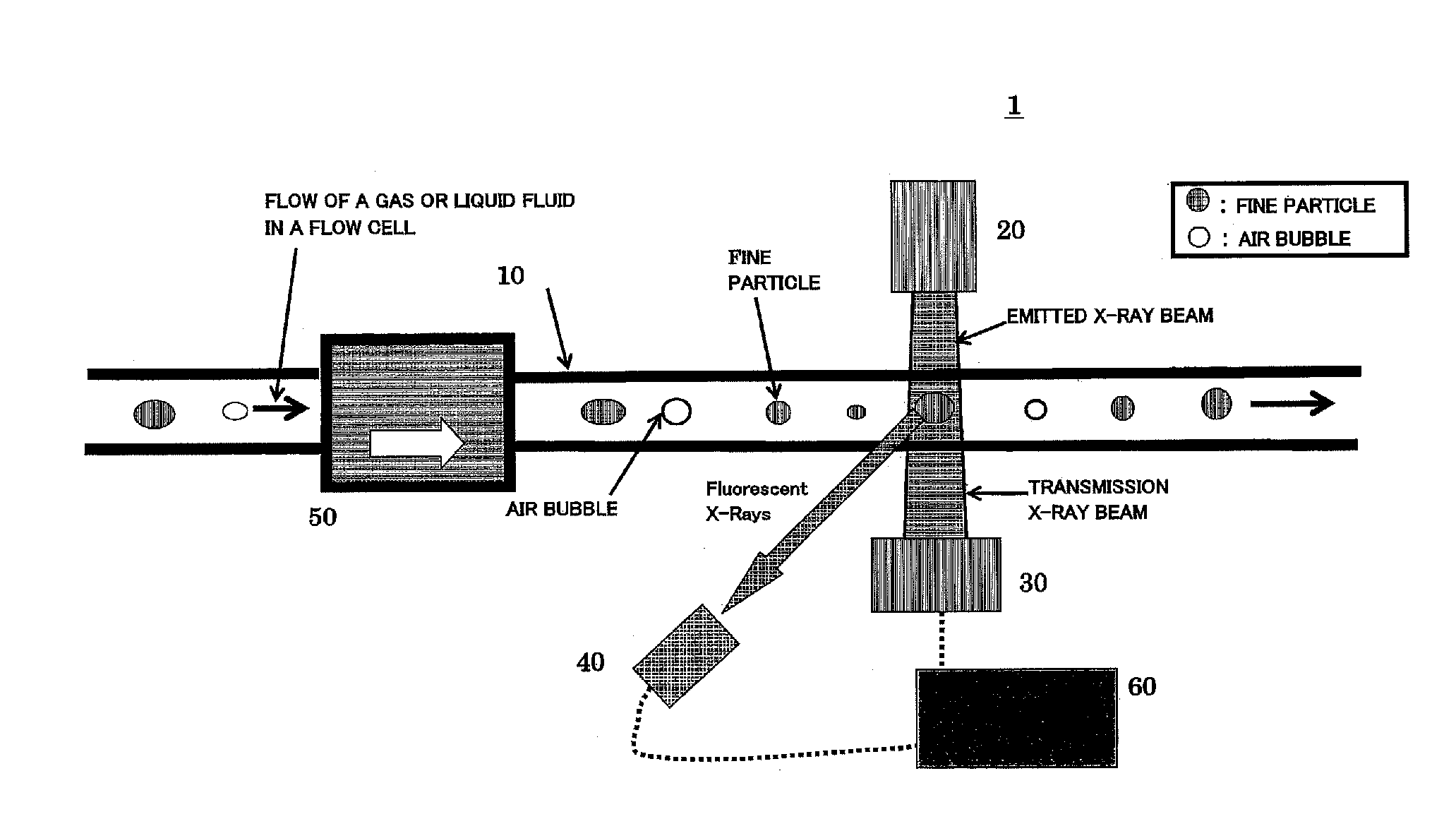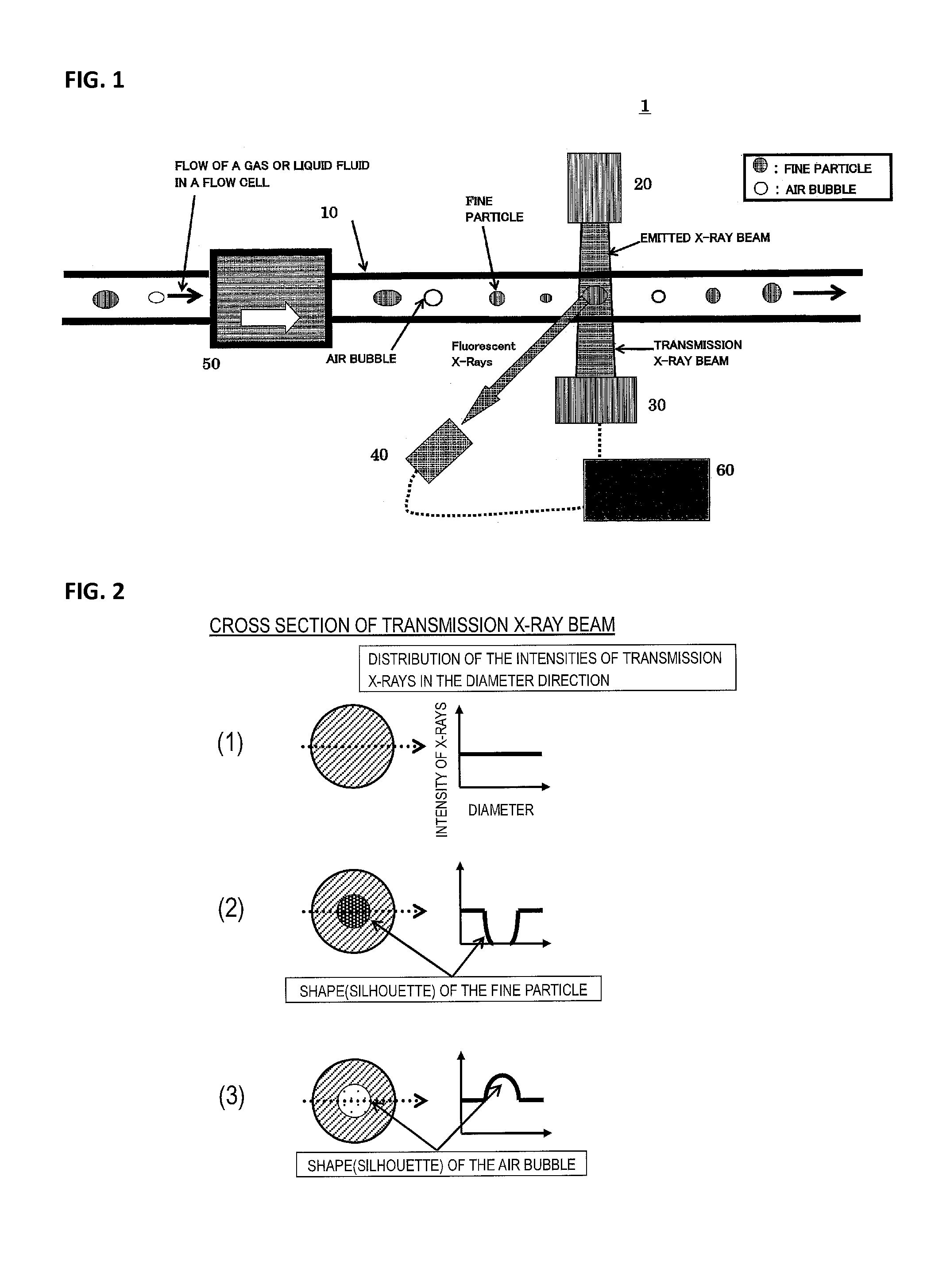In the scattering method, when the particle diameter of the fine particles becomes large, the relationship between the particle size and the intensity of scattered light becomes complicated, and the intensity of scattered light greatly varies according to the particle shape, which accordingly makes it difficult to accurately measure the particle size.
In the light-shielding method, when the particle size becomes small, the amount of shielded light becomes small, and the measurement error of the fine particles becomes large.
However, the light-scattering method and the light-shielding method which irradiate the fine particles with light or a laser have a problem of measuring air bubbles contained in the fluid as fine particles, when measuring the fine particles contained in a liquid fluid in a flow cell.
Air bubbles in a liquid have a refractive index largely different from that of a liquid passing in the flow channel, and accordingly refract the light on the interface between the liquid and the air bubbles, which results in scattering of the light.
For this reason, when fine particles in the liquid are measured with the scattering method and the light-shielding method, there is a fatal problem that the number, the concentration and the distribution of particle diameters of the fine particles cannot be accurately measured and errant measured data is shown.
In addition, when more air bubbles exist in the liquid than the concentration of the fine particles, the effect of the light-scattering or the light-shielding of the light due to the air bubbles becomes remarkable, the effect of the light-scattering and the light-shielding due to the fine particles is strongly interfered by the effect of the light-scattering and the light-shielding due to the air bubbles, and as a result the measurement of fine particles is impossible.
However, it is difficult to completely separate or remove air bubbles even with these techniques of separating the air bubbles or defoaming, and a few fine air bubbles remain in the portion to be irradiated with the light or the laser in the flow channel.
In order to discriminate air bubbles from fine particles as much as possible, and actually measure the fine particles in the liquid with high accuracy, it is necessary to use an ultrasonic wave, an electrophoretic force or a centrifugal force, to pressurize the liquid to a high pressure, to heat the liquid to an extremely high temperature or cool to an extremely low temperature, or to use each of these techniques in combination, which causes a great problem in developing the product of a measurement instrument that such an apparatus for separating the air bubbles becomes complicated and upsized, and further that a final cost concerning the measurement also increases.
In addition, when the fine particles in an oil product such as a lubricating oil are measured, there are also problems in that the optical transparency of incident light or laser light in the lubricating oil decreases due to coloring and the like caused by the deterioration of the lubricating oil, a normal irradiation intensity of the laser for the fine particles in the lubricating oil cannot be obtained because of the decay of the light by the lubricating oil, the intensity of the scattered light by the fine particles in the lubricating oil also decays, and accordingly the number and the particle diameter of the fine particles cannot be accurately measured.
Then, the light cannot pass through the liquid, and the measurement of fine particles becomes impossible.
Moreover, in the scattering method and the light-shielding method, when the fine particles to be measured are constituted by the same substance, a correlation is obtained between the intensity of the light signal obtained by the light-scattering or light-shielding and the particle size; but when the fine particles are made from different elemental compositions, the correlation cannot be obtained between the intensity of the signal and the particle size, because the fine particles made from different elemental compositions show different refractive indexes, characteristics of scattering the light, absorbing the light and transmitting the light and the like, which are optical characteristics of the fine particles; and the number of the particles and the particle diameter cannot be accurately measured.
In the scattering method, when the fine particles are made from a substance which scatters little light or a substance which absorbs light greatly even though the particle diameter is the same, the intensity of the light signal of the scattered light coming from the fine particles becomes extremely small, and the signal is not counted as a signal, which consequently causes a count loss.
Furthermore, even if the fine particles are made from the same substance, the scattering characteristics of the light are different between the case in which the surface shape of the fine particles is uneven and is complicated and the case in which the surface is smooth, and accordingly the particle diameter cannot be exactly measured.
In the light-shielding method, even if the fine particles have the same particle diameter, when the substance of the fine particles absorbs little light and has a large transmittance for the light, a light-shielding effect due to the fine particles is small, and the fine particles are not counted as particles similarly to the case in the scattering method, which results in causing a count loss.
However, the technologies described in Japanese Patent Laid-Open No. 11-83767 and Japanese Patent Laid-Open No. 2006-29921 are both directed at detecting a specific element, are restricted to detecting the specific spectrum of the fluorescent X-rays, and accordingly cannot detect all fine particles contained in the fluid.
 Login to View More
Login to View More 


